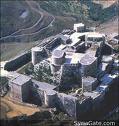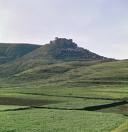 Krak des Chevaliers, also transliterated Crac des Chevaliers, is a Crusader fortress in Syria and one of the most important preserved medieval military castles in the world. In Arabic, the fortress is called Qal'at al-hison (Arabic: قلعة الحصن ), the word Krak coming from the Syriac karak, meaning fortress.It is located 65 km west of the city of Homs, close to the border of Lebanon, and is administratively part of the Homs Governorate.
Krak des Chevaliers, also transliterated Crac des Chevaliers, is a Crusader fortress in Syria and one of the most important preserved medieval military castles in the world. In Arabic, the fortress is called Qal'at al-hison (Arabic: قلعة الحصن ), the word Krak coming from the Syriac karak, meaning fortress.It is located 65 km west of the city of Homs, close to the border of Lebanon, and is administratively part of the Homs Governorate.
Krak des Chevaliers was the headquarters of the Knights Hospitaller during the Crusades. It was expanded between 1150 and 1250 and eventually housed a garrison of 2,000. The inner curtain wall is up to 100 feet thick at the base on the south side, with seven guard towers 30 feet in diameter.
 King Edward I of England, while on the Ninth Crusade in 1272, saw the fortress and used it as an example for his own castles in England and Wales. The fortress was described as “perhaps the best preserved and most wholly admirable castle in the world” by T.E. Lawrence. This fortress was made a World Heritage Site, along with Qal’at Salah El-Din, in 2006 and is owned by the Syrian government. The fortress is one of the few sites where Crusader art (in the form of frescoes) has been preserved.
King Edward I of England, while on the Ninth Crusade in 1272, saw the fortress and used it as an example for his own castles in England and Wales. The fortress was described as “perhaps the best preserved and most wholly admirable castle in the world” by T.E. Lawrence. This fortress was made a World Heritage Site, along with Qal’at Salah El-Din, in 2006 and is owned by the Syrian government. The fortress is one of the few sites where Crusader art (in the form of frescoes) has been preserved.
The castle is located east of Tripoli, Lebanon in the Homs Gap, atop a 650-meter-high hill along the only route from Antioch to Beirut and the Mediterranean Sea. It is one of many fortresses that were part of a defensive network along the border of the old Crusader states. The fortress controlled the road to the Mediterranean, and from this base, the Hospitallers could exert some influence over Lake Homs to the east to control the fishing industry and watch for Muslim armies gathering in Syria


